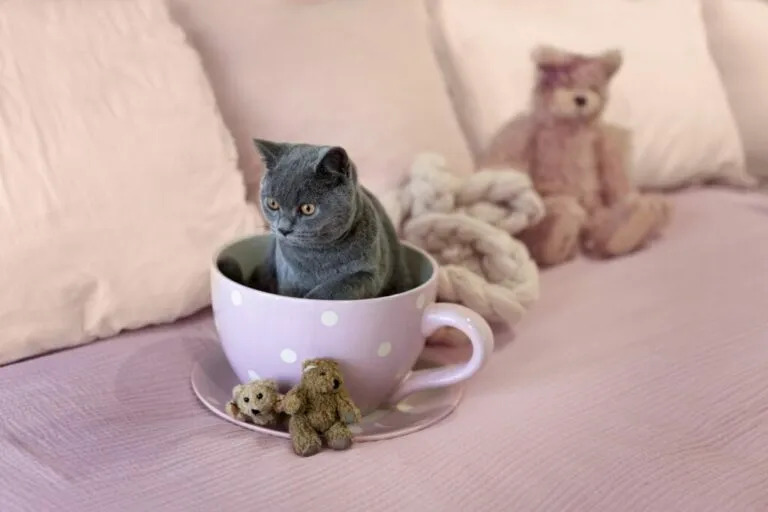Teacup cats are so small that they fit in a teacup – even when they are fully grown up. However, these tiny cats pay for their cute appearance with severe health problems.
Photos of teacup cats sitting in a teacup are very popular.
The internet is full of photos of sweet little cats sitting in teacups. These are mostly young kittens that are not yet fully grown. But what about the cats that stay this small and cute?
Mini cats are getting more and more popular, particularly in the US. These tiny little cats are called teacup cats, precisely because they fit in a teacup.
What do teacup cats look like?
Teacup cats basically look like normal cats – just much smaller. Their body size is around two-thirds that of a normal-sized cat.
Whilst an adult domestic cat weighs around 5kg, a teacup cat only weighs 2.5-3kg.
Teacups aren’t a stand-alone cat breed. They are miniature versions of all possible cat breeds. This means that their build, fur texture and character traits are similar to their original breed. Miniature Persian cats are particularly popular.
Teacup cats aren’t dwarf cats
In terms of proportions, teacup cats don’t differ from their bigger siblings. In comparison to the torso, their legs are of normal length. This differentiates them from Munchkin cats, for instance, which are a dwarf cat breed with shortened Dachshund-like legs.
Breeding: How do teacup cats get so small?
The breeding objective is to produce a cat as small as possible. In order to achieve this, animals with a below-average body size are paired with one another, and this can cause problems:
Some cats may simply turn out smaller than the average cat. However, there is a congenital disability or illness behind the short stature of many cats. Malnutrition can also lead to a cat not growing properly.
Normally such weaklings don’t survive for long and don’t breed. However, if these animals are bred, the offspring often have severe health defects.
Health: Small bodies – big problems
Regardless of the breed, teacup cats suffer from dental problems more often than normal-sized cats. These tiny cats tend to suffer from injuries due to their small bones and joints. Complaints like arthritis also occur frequently. It has also been established that teacup cats cannot regulate their body temperature very well.
Overall, teacup cats do not have a particularly high life expectancy. According to experts, they only live for a few years.
Teacup Persians are particularly prone health problems
Mini versions of cat breeds that already suffer from health problems anyway are particularly prone to illness. For instance, the mini version of Persian cats has a higher probability of suffering from eye infections.
The typical Persian nose is even shorter with Teacup Persians, which increases the risk of respiratory problems. Impaired jaw function and therefore difficulty chewing food is also more common with Teacup Persians.
Furthermore, Persians tend to suffer from polycystic kidney disease (PKD). Vets believe it is possible that the risk is higher due to smaller kidneys.
There are miniature dogs too
There are also mini dogs known as ‘Teacup Chihuahuas’. However, teacup dogs are frowned upon by reputable breeders. Breeding them is seen as animal abuse because mini dogs suffer from health impairments just as seriously as mini cats do.
Thinking of buying a teacup cat?
You rarely find teacup cats for sale in these parts. On the other hand, breeders in the US ask for between 500 and 2,000 US dollars for a mini cat.
Due to health concerns, teacup owners can expect frequent trips to the vet – this can get expensive over time. Above all, you should avoid buying one of these cats and think twice about supporting this worrying trend for ethical reasons!
If you like small cat breeds, you should take a look at breeds such as the Singapura or the Abyssinian cat instead.
When making a purchase, be sure to choose a reputable breeder who will let you take a good look at the paperwork for their animals. It is also very important to get an impression of the living conditions.
It can also be worthwhile visiting a local animal shelter because it’s not uncommon for pedigree cats to end up there.
Source:
https://www.petmd.com/cat/general-health/truth-about-teacup-cats
